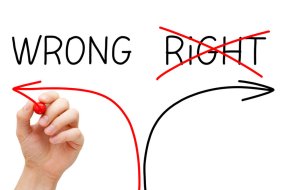
In this week’s blog, I’m taking a closer look at ethical practices within marketing research. In an article called Ethical Problems of Marketing Researchers (Hunt, Chonko, Wilcox, 1984), the authors assess four research topics:
- The major ethical problems of marketing researchers;
- To what extent professional codes of conduct address the major ethical problems of marketing researchers;
- How extensive are ethical problems of marketing researchers;
- How effective are the actions of top management in reducing the ethical problems of marketing researchers?
In order to find out more about the major ethical problems the authors conducted a research based where they asked marketing researchers the following question:
“In all professions, managers are exposed to at least some situations that pose a moral or ethical problem. Would you please briefly describe the job situation that poses the most difficult ethical or moral problems for you?”
After they conducted their research, they concluded that “Research integrity” was the leading category and accounted for 33% of all responses. Research integrity includes withholding information, falsifying data, altering research results, misusing statistics, ignoring pertinent date, compromising the design of a research project, and misinterpreting the results of a research project with the objective of supporting a predetermined personal or corporate point of view. “Treating outside clients fairly” was the second highest category with 11%, where one of the researchers that was being surveyed responded that “hidden chargers are often passed on to the customer and reversed only if the customer complains.” The third highest category that resulted from the research that the authors conducted was “Confidentiality”, where most confidentiality problems came from trying to balance their obligations toward different outside clients. Other ethical issues that resulted from the research that was conducted were (in order of importance): social issues, personnel issues, treating respondents fairly, treating others in the company fairly, interviewer dishonesty, gifts, treating suppliers fairly, legal issues, misuse of funds, other.
The authors of the research came to nine different conclusions to answer their four research topics. The article Ethical Problems of Marketing Researchers (Hunt, Chonko, Wilcox, 1984) states the following conclusions:
- The most difficult ethical problem facing marketing researchers is maintaining the integrity of their research efforts.
- The primary ethical conflicts for in-house researchers are: balancing the interests of self against the interests of other parties and balancing the interests of the company against the interests of other parties.
- All of the primary ethical conflicts of agency researchers involve balancing the interests of their outside clients against the interests of various other parties.
- Though marketing researchers perceive many opportunities for engaging in unethical behavior, they perceive a relatively low frequency of unethical behavior.
- Marketing researchers do not believe that unethical behaviors in general lead to success in marketing research.
- A relatively large portion of marketing researchers believe that successful managers reduce the ethical problems of marketing researchers.
- The actions of top management in dealing unethical behavior can significantly reduce the ethical problems of marketing researchers.
- The presence of either corporate or industry codes of conduct seem to be unrelated to the extent of ethical problems in marketing research.
- In comparison with the official American Marketing Association code of conduct for marketing research, the code proposed by the New York Chapter covers many more of the most difficult ethical issues facing marketing researchers.
 The most interesting conclusion that the authors made was conclusion eight. I was surprised to see that the research results showed that corporate and/or industry codes of conduct have no significant relationship with the extent of unethical practices in marketing research. This means that a lot of marketing researchers neglect their company’s policies regarding marketing research to show “positive” results to top management. What I learned from this is that as a student doing research, we have to be careful and mindful about how we analyze data. As a student doing a research project, you can’t just read one journal article and perceive everything the author says as one hundred percent correct. You have to be able to proof what the author says by finding additional research that concludes the same thing.
The most interesting conclusion that the authors made was conclusion eight. I was surprised to see that the research results showed that corporate and/or industry codes of conduct have no significant relationship with the extent of unethical practices in marketing research. This means that a lot of marketing researchers neglect their company’s policies regarding marketing research to show “positive” results to top management. What I learned from this is that as a student doing research, we have to be careful and mindful about how we analyze data. As a student doing a research project, you can’t just read one journal article and perceive everything the author says as one hundred percent correct. You have to be able to proof what the author says by finding additional research that concludes the same thing.
After analyzing the top three major ethical difficulties represented in the article, I agree with conclusion seven of the authors. I think that the actions of top management within an organization to judge unethical behavior are extremely important to reduce this behavior within the company. When a company does not take the appropriate actions, it could result in making the wrong strategic decisions which will have a negative effect on not only the company’s profits, but also on the company’s image and reputation.
Several actions top management could take to deal with unethical issues like research integrity, treating outside clients fairly, and research confidentiality are presented in a blog by Emily Douglas called 7 Practices to Prevent Unethical Behavior. I believe that the two last practices that she addresses are the most important ones. By building a culture of transparency, openness, and communication, the organization creates an environment where everybody feels comfortable about expressing their true thoughts. In this environment, marketing researchers wouldn’t feel the need to for example withhold information or falsify data because they know they are valued for speaking their mind. Also, and this refers to the last practice presented by Emily Douglas, it is very important that top management who present the importance of the policies of the organization to their employees. This goes along with conclusion seven made by Hunt, Chonko, and Wilcox (1984). Top management needs to make sure that they also stick strictly to the policies they inducted into their company. When employees find out that their top management is behaving unethically, this will cause distrust and give employees like for example marketing researchers to also break the policies made around ethical behavior.
Both the research article Ethical Problems of Marketing Researchers (Hunt, Chonko, Wilcox, 1984) and Emily Douglas’ blog post 7 Practices to Prevent Unethical Behavior are a very interesting read and worth checking out.
 Another blog post by Stephanie Liou, called “Animal Research: The Ethics of Animal Experimentation”, argues both sides of the topic. I think she is bring forth some very interesting points for both cases. She also presents a middle ground with tries to limit the use of animals for scientific research, but doesn’t necessarily completely ban it. In her case against animal experiments, her strongest argument is that animals deserve to receive the same respected treatment as humans.
Another blog post by Stephanie Liou, called “Animal Research: The Ethics of Animal Experimentation”, argues both sides of the topic. I think she is bring forth some very interesting points for both cases. She also presents a middle ground with tries to limit the use of animals for scientific research, but doesn’t necessarily completely ban it. In her case against animal experiments, her strongest argument is that animals deserve to receive the same respected treatment as humans.

 The most interesting conclusion that the authors made was conclusion eight. I was surprised to see that the research results showed that corporate and/or industry codes of conduct have no significant relationship with the extent of unethical practices in marketing research. This means that a lot of marketing researchers neglect their company’s policies regarding marketing research to show “positive” results to top management. What I learned from this is that as a student doing research, we have to be careful and mindful about how we analyze data. As a student doing a research project, you can’t just read one journal article and perceive everything the author says as one hundred percent correct. You have to be able to proof what the author says by finding additional research that concludes the same thing.
The most interesting conclusion that the authors made was conclusion eight. I was surprised to see that the research results showed that corporate and/or industry codes of conduct have no significant relationship with the extent of unethical practices in marketing research. This means that a lot of marketing researchers neglect their company’s policies regarding marketing research to show “positive” results to top management. What I learned from this is that as a student doing research, we have to be careful and mindful about how we analyze data. As a student doing a research project, you can’t just read one journal article and perceive everything the author says as one hundred percent correct. You have to be able to proof what the author says by finding additional research that concludes the same thing.

